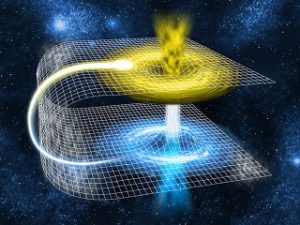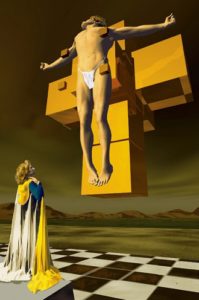
Arquivo para a ‘Cognition’ Categoria
The first quantum computer hub
The North Carolina State Unit was chosen by IBM to have the first Quantum Computing Hub (Q Hub that became part of IBM’s Network Q), as well as the first networks linking some universities.
(Q Hub that became part of IBM’s Network Q), as well as the first networks linking some universities.
On December 5, 1969, ARPANET joined the Research Agency of the US Department of Defense, the University of California, Los Angeles (UCLA), the Stanford Research Institute (SRI) at Menlo Park, the University of California, Santa Barbara (UCSB) and the University of Utah (photo).
Students, faculty and researchers will be able to access IBM’s 20-bit supercomputer to solve classic computing problems that would take a long time to process, now they will be done in a few minutes depending on the problem.
Bob Sutor of IBM Research said “we can not create a computer with 10% of the Earth’s atoms, but even so, with the quantum computer we can represent exactly this information”, according to a post on Techinician Online.
IBM’s plan is more audacious, with Fortune 500 companies and universities working to solve larger problems more quickly through the Q Network, while NC State will be collaborating with local organizations to solve complex equations.
NC State faculty are developing both undergraduate and graduate courses to use quantum computing to build their knowledge in anticipation of the hub’s operational debut this fall (in September).
We are so connected this way
The so-called “small world” phenomenon, worked on and addressed in Social Network Analysis (not to be confused with social media) is the idea that everyone can be connected through only six degrees of separation, and this has inspired not only scientists , but also artists, journalists, business people and the general public since the idea emerged in a 1990 John Guare play.
confused with social media) is the idea that everyone can be connected through only six degrees of separation, and this has inspired not only scientists , but also artists, journalists, business people and the general public since the idea emerged in a 1990 John Guare play.
Despite recent appearances of this concept in the media, illustrating the widespread belief in universal connectivity, there is also controversy over the same claim, and Barabási’s non-scale model is one of them, though his book Linked: the New Science of networks (2009) is the best reading of the topic.
Two examples cited are “Xing,” a network of potential subscribers referring to the idea of ”six degrees of separation,” and the attempt by the American television network ABC to conduct its own version of an experiment to test the same idea , through a “six degree” charity initiative using the concept on their website in an attempt to collect donations to a network of various charities.
Although Milgram’s experiment has already dealt with the subject, a manuscript by Pool and Kochen (Contacts and influence Social Networks, 1 (1978)) circulating around 1958 would have been the first version of the idea, but it was only published 20 years later, then not everyone gives credit.
The important thing about Pool and Kochen’s work is that they tried to give a mathematical structure to their “contact networks” following the path of other theorist as the mathematician. Rapoport (Spread of information through a population with socio-structural bias: I. Assumption of transitivity, 1953).
One prank to take this test is to use “Bancon’s Oracle” (by Kevin Bacon) on oracleofbacon.org and get the connection of Pope Francisco with Toshirô Mifune, for co-performances in films, the pope has already participated in two movies (see above)
Effect contested by Einstein is proven
The phantasmagoric effect at a distance, which is the fact that particles can relate  to distance and the effect of being “felt” by the other distance, is definitely proven in an experiment published by Nature on May 9.
to distance and the effect of being “felt” by the other distance, is definitely proven in an experiment published by Nature on May 9.
This test is called Bell, due to John S. Bell, was first shown by Alain Aspect who did an optical experiment in 1982, showing this action at a distance. Now the experiment was done recruiting 100,000 human participants to play an online video game that encourages the rapid entry of unpredictable selections and illustrates Bell’s test methodology, participants generated more than 97 million binary choices that were directed through a Web platform Scalable to 12 labs on five continents, where 13 experiments tested local realism using unique atomic photons, atomic clusters and superconducting devices (illustration).
For a period of 12 hours on November 30, 2016, participants around the world provided a sustained data stream of more than 1,000 bits per second for the experiments, using different human-generated data to choose each measurement configuration, correlations strongly contrast local realism and other positions in so-called bipartite and tripartite scenarios.
The results of the project included closing the “freedom of choice” gap (the possibility of scenario choices being influenced by hidden variables to correlate with particle properties), the use of video game methods for the rapid collection of generated randomness and the use of network techniques for global participation in experimental science.
Two data are fantastic from this experiment, proving the phantasmagoric distance action that Einstein contested in an article called EPR, the use of network methodologies in participation in global experimental science, and the use of the video games to simulate data.
How do we think it is to think
From the Algebra of 0 and 1 of Boole, through the first computers of Charles Babbage, arriving  at the thoughts of Vannevar Bush and Norbert Wiener of the MIT of the 40, we came across Alan Turing and Claude Shannon, the final question: the machine one day will think
at the thoughts of Vannevar Bush and Norbert Wiener of the MIT of the 40, we came across Alan Turing and Claude Shannon, the final question: the machine one day will think
What we see between Sophia Robot’s investment appeal to the “personal assistants” market is a long history of what it means to think, but the question now due to technoprofets (name given to the alarmists by Jean-Gabriel Ganascia) is inevitable.
Vannevar Bush had a data processing machine in his MIT lab, where he went to work a trainee named Claude Shannon, says James Gleick who was the one who suggested to his student that he study Boole’s Algebra.
Vannevar Bush in his historical text As We May Think, although it does not say as we would think, speaks of the future possibilities of new advances: “Consider a future device … in which an individual stores all his books, records, and communications, and which is mechanized so that it may be consulted with exceeding speed and flexibility. It is an enlarged intimate supplement to his memory.” (Bush, As We may think).
It creates the embryonic idea of a computer that relates text, as it has done in searches since the beginning of the Gutenberg print, but its Memex machine (picture) was already thought of as a vast capacity of records and communications, even if the phone was still nascent in the final years of World War II and communications depended on powerful antennas.
What is certain is that in the end your text little or almost nothing says about what is actually thinking and as it still is today in Artificial Intelligence, what we have done is to expand more and more the capacity of memory and communication, as well as of large amounts of data, now with techniques called Big Data.
Another contemporary tendency is to ask for the autonomy of the machines, the experiments carried out, even with the so-called “autonomous vehicles” are the basis of algorithms and they depend on the decision making of how the human being will do in certain circumstances, in critical cases, like deciding between two tragedies, the choice can be terrible.
Clearing and revelation
Will there be in the whirlwind of answers and anguishes of the man of our time, present more than ever in our daily thinking and also in those who seek the roots of our contemporary difficulties? What is the maze with no way out?
our time, present more than ever in our daily thinking and also in those who seek the roots of our contemporary difficulties? What is the maze with no way out?
The answers are not the same, but the diagnoses are almost always the same, in addition to the pessimistic baumanian liquidity, the diagnosis is the needs of education for life, respect for diversity, income distribution, and man’s empowerment for this future .
Although the majority already feel and see the awakening of this new era, the reactions to the changes that are more than necessary, are urgent, there is greater balance in the planet, control of tax havens, elimination of atomic weapons, and especially respect for diversity.
What keeps us still are the closures in bubbles, which despite the “liquidity” can not be solid, since they are ephemeral and just look around you will find people from other world views, other cultures and other religions, this is solid and definitive.
What Strikes Us Attention Byung-Chul Han in The Expulsion of the Other, I believe is his most recent book, is that the tendency toward uniformity, even the desire for it, stems from not-so-solid values, the demand for a centralizing and ” strong, “the lack of truly open dialogue between religions, cultures, and especially ideologically centralized currents, will not carry out the task of a new, more collective, more dialogic and fraternal society.
There is no single answer, single party, Portugal for example, created the Gerigonça, but still we are slaves of convictions and bets on single totalitarian currents that have failed to much.
The biblical message is old, but it seems to have been little practiced, the time of bondage has passed, says the biblical passage, of Jesus to his fellows Jo (15,15) “No longer do I call you servants, for the servant does not know what your lord. I call you friends, for I have made known to you all that I have heard from my Father “, but slavery is there, says Chul Han:” global communication and of the likes only tolerates the most equal; the same does not hurt! “, this is today’s bondage.
Utopia and Confusion
Before proceeding to show the relation between being and technique,  one must make a digression for the catastrophic technician-prophecies and the confucioness, that is to say, it is called network nor everything that is network, lends itself the artificial intelligence to human while the opposite is true, and finally, post-human machines are created without an existential response to man.
one must make a digression for the catastrophic technician-prophecies and the confucioness, that is to say, it is called network nor everything that is network, lends itself the artificial intelligence to human while the opposite is true, and finally, post-human machines are created without an existential response to man.
Brade Runner 2049 could not succeed, who better than the first one takes a plunge into the human existential problem, while “Androids dream of electric sheep?” Asks in his book Philip K. Dick, who inspired the films of the series, is 1968 (sic), including a hardcover edition to celebrate the 50 years recently.
Confusioness is a term coined by Lucien Sfez, who in addition to communication participated in the projects Genome, Biosphere II and Artificial Life, so it is not someone who speaks without understanding the possibilities, the daydreams and the challenges of technology.
At the same time recognizes, among the daydreams of course, “The utopia of a total record; to make a being in our image, as a man is that of God, thanks to science, indisputable, transparent, luminous as a sacred gladius; the belief in the omnipotence of an electronic science; the illusion of freedom; and the creation of a perfect machine “(SFEZ, 1996).
I would not use the word utopia, I consider it a confusioness one, since what Thomas Morus wrote would be a community society without attachments and with a “social health” greater than that dreamed by the Enlightenment, and which is the very science that created this confusional and not Thomas Morus (1478-1535), was not a dreamer was a statesman, held various public offices, including Henry VIII’s chancellor, who was precisely his tormentor for religious reasons.
The limits of the technique are within the possibilities and challenges, among these are those that allow space travel no longer in large ships, but in micro-ships that would travel in quantum worm-holes and computers that use larger techniques volume of data, with greater volume of data communicated and processed.
In the field of possibilities it is worth reading “Physics of the Impossible” (2008) by Michio Kaku, among the field of challenges is worth reading “Le Mythe de la Singularité” by Jean-Gabriel Ganascia (2017), who tunes the challenges of Artificial Intelligence and punctuates points of pure fantasy.
I will not resort to more arguments, it is impossible to convince anyone in the field of hypotheses does not abandon the hypothesis of the transhuman or the machine smarter than the man, just see the delusions about today’s social media, use the argument of a saint, perhaps few will know this phrase of St. Francis: “Begin by doing what is necessary, then what is possible, and suddenly you will be doing the impossible”, it is true that it speaks in the field of mysticism, but who said that it is separated from the physical world or at least the meta- physicist.
SFEZ, Lucien. (1996) Saúde Perfeita – crítica a uma nova utopia (Perfect health – criticism of a new utopia). São Paulo: Loyola.
Education is the way out?
Despite major improvements in recent years, progress toward education for all has stagnated globally, few initiatives exist to make leaps higher, Open Education for All in Massive Online Courses can be the solution?
education for all has stagnated globally, few initiatives exist to make leaps higher, Open Education for All in Massive Online Courses can be the solution?
In total, 263 million children, adolescents and young people so out of school for the school year that ended in 2016, statistics for 2017 were not at all optimistic.
This means that more equitable progress will become increasingly difficult if huge barriers are built already in youth education will be doomed to emergency resources rather than to an equitable and sustainable improvement of the distribution of assets across the globe. The reason why this process is not equitable has some evidence: children face the most severe barriers to education that have a lower chance of professional and personal development, this becomes dramatic when they are associated with gender, poverty, displacement, nomadism, disability and / or ethnicity, and even when they are left behind in displacements due to wars.
There is a disproportionate number of out-of-school children living in countries characterized by instability and conflict and / or extreme poverty, little is said about Africa, but every day there is a new conflict. Many of the countries with the greatest number of out-of-school children do not have adequate outside funding or funding to meet their needs, and the NGOs and actions of some countries are localized and loss-making.
Beyond the obvious question of a global policy of income distribution is a massive attack on the issue of education, if armaments money were invested in this, we would have great solutions in the medium term, the short would be a strong intervention to the UN.
Phantasmagoric and realism
Undoubtedly, reality may not only be what our senses indicate, but also the senses are part of a good discovery of reality, one can use a glasses, a microscope and a powerful telescope to see reality, but using the eye.
indicate, but also the senses are part of a good discovery of reality, one can use a glasses, a microscope and a powerful telescope to see reality, but using the eye.
What is difficult to imagine is how constructing narratives can deceive reality, can make it different from what the simple vision indicates, for example, it could be imagined that quantum physics would give rise to a called the “physical world”.
Einstein, Podolsky and Rosen; three eminent physicists at the time, wrote an article that counterposed the idea of quantum physics, that quanta occupied a space between “pulses” and that there was nothing between them, they said three physicists was a “phantasmagoric” distance action and mathematically proved to be something impossible, the phenomenon became known as EPR (initial letters of the authors).
Recently, in a study led by Ronald Hanson and published in Nature magazine in 2015, the Delft University of Technology in the Netherlands reported having done an experiment which, according to them, proves one of the most fundamental assumptions of quantum theory – that separate objects by a great distance can affect one to other.
The apparitions of Jesus, in various events, after his departure and resurrection brought astonishment and even fear to his disciples, in a little known passage appears to several people and says (Lk 24: 38-39): “Why are you worried, and Why do you have doubts in your heart? See my hands and my feet: it is I myself! Touch me and see! A ghost has no flesh, no bones, as you see I have, ”
Unfortunately he is still a ghost and even a legend to many.
The real (im)possibilities
In addition to contemporary idealistic thinking, I surrender to the fact that part of it started from religious presuppositions attached to mechanicism and the order of the universe, there is a set of possibilities that have long been thought of, and some proven, as we have previously posed quantum physics and the real possibilities of science.
presuppositions attached to mechanicism and the order of the universe, there is a set of possibilities that have long been thought of, and some proven, as we have previously posed quantum physics and the real possibilities of science.
In The Physics of the Impossible, Michio Kaku, who has a famous book on hyperspace, uses an unexpected feature, the idea that in all religions there are other dimensions of life, he wrote: “The church believed in Heaven, Hell, and Purgatory. Buddhists have Nirvana and various states of consciousness. And the Hindus have thousands of planes of existence “(p.236), they do not know but could be quoted the cosmogonies of various cultures and religions where orality prevailed and many of these tales speak of other dimensions.
The author acknowledges that in literature there are at least three types of parallel universes: hyperspace, or higher order dimensions, the multiverse (nonuniversity), and the quantum parallel universes.
The fact that we are attached to the three dimensions, clarifies the author comes from Aristotle, that his work On the sky, established the width, height and depth, which are translated into three ideal dimensions: the point, the straight and the plane, which are inexistent if examined in the real nature, the fractals are a modern rediscovery (a monk had already conjectured) of the rupture of these dimensions to the one natural plane, is the natural fractional, where dimensions 0.7 or 2.78 exist.
The author says that Carl Gauss had already conjectured these dimensions, but it was a pupil of his that overthrew with a simple example this theory idealista supposing a sphere, in her the minimum distance between two points is an arc and not a straight, and a triangle will have more of 180 degrees in the sum of the angles.
For the fourth dimension, it is a surprising feature of art historian Linda Darymple Henderson who wrote: “Like the black hole, the ‘fourth dimension’ had mysterious characteristics that could not be fully understood, not even by the scientists themselves . “(P. 238), recognizing the importance of this theory.
He also cites Salvador Dali’s picture Christus Hypercubius (stylized image above), he is “crucified before a strange and hovering trimester cross that is a reality in” tesseract “, a four-dimensional cube unfolded” (page 238)
Movies like “Contact” made from the novel by Carl Sagan and “Interestellar” where ships travel in the fourth dimension, wormholes may already be virtually possible, a project that has more than 100 million dollars, was launched in England in 2016 and has Stephen Hawking’s support, could micro-ships travel in this dimension?
The future will still bring surprise and there will be no shortage of false prophets succeeding against i
They aren´t deaf but not listen
The physiological fact of listening can be in contrast with the apprehension of the content in the human brain, that is, one can have a suitable hearing aid or even artifacts that help, but even listening, do not listen, that is, they do not apprehend the content.
apprehension of the content in the human brain, that is, one can have a suitable hearing aid or even artifacts that help, but even listening, do not listen, that is, they do not apprehend the content.
McLuhan’s view that communication as a medium tends to be defined as transparent, innocuous, unable to determine what are the communicative contents that are conveyed.
Its only effect on the artifact, whatever it was, in the communication process would be negative, due to noises or obstacles in the delivery of the message, this was already the preoccupation as a device of Claude Shannon, but now McLuhan calls either the message made orally or in writing, be it transmitted by radio, television, puts in play new structures being artifacts intended to broaden the senses highlighting contours and other nuances of what is communicated, in this work relates to the artist who wishes to highlight something.
Put more directly, for McLuhan, the medium, the cane (terms more appropriate for Shannon), the technology artifacts that communication establishes, is not only a form of communication, but will ultimately determine the own content.
What McLuhan points out is the fact that a message delivered both orally as in writing, when broadcasting on the radio or television sets the content.
Their central thesis is that there is a double operation: 1) to study the evolution of the communal media used by men throughout their history, and 2) to identify the specific characteristics of each of these different media / communication artifacts .
These are two central points of his investigation that are at the root of one of his fundamental works, namely Understanding Media, of 1964.
Thus develops three galaxies, when only one is remembered, the Gutenberg Galaxy, which is typical of the written culture and then printed with the possibilities of reproducibility, but there is the oral or acoustic cultural that is previous, where the question of listening is fundamental (orally speaking), oracles and prophets occupy a central role, and the present one that McLuhan called electronic, but it is possible as an extension to speak of a digital galaxy in network, where there are media of networks that do not must be confused with the networks, since they exist in the previous galaxies.
So those who are trapped in the Gutenberg galaxy do not listen to oral culture, and those who are trapped in the culture of pure technology do not listen to oral and written culture

